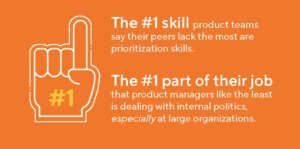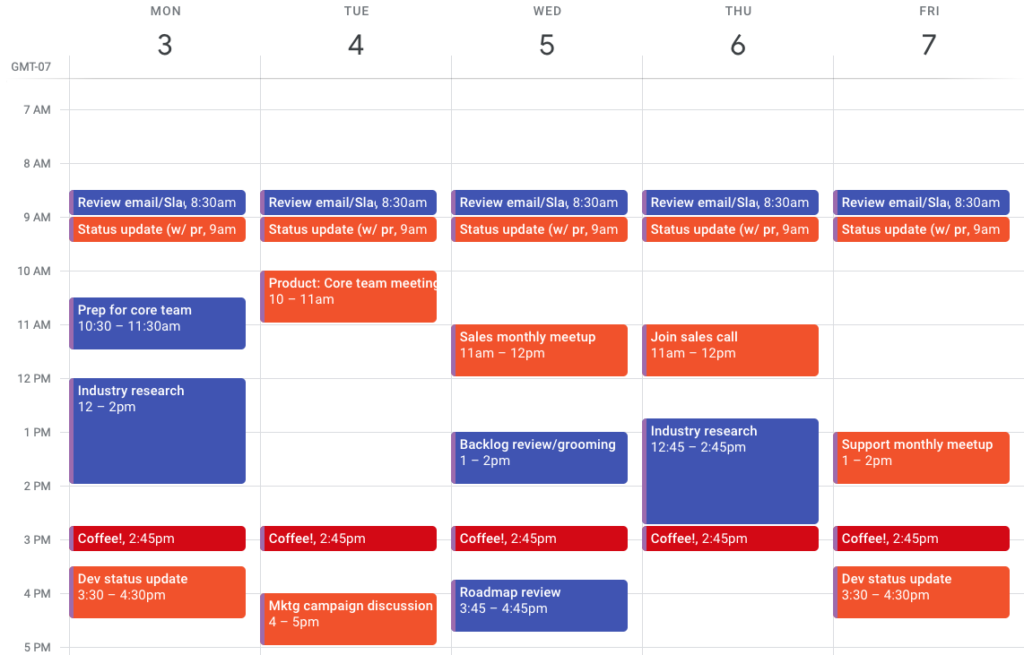What Does a Product Manager Do?
Before we jump into a discussion about the tasks and events that fill up a day in the life of a product manager, we first want to give you a clear definition of the role. What does a product manager do? Here’s our one-sentence answer:
A product manager identifies market problems worth solving and then leads the group that will solve those problems.
In our experience working with product managers in all industries, we’ve found that the product manager’s job can be grouped into three major categories at companies of all sizes.
The 3 Major Categories of a Day in the Life of a Product Manager
1. Connecting and communicating
2. Learning and analyzing
3. Deciding and documenting
Here are examples of everyday tasks and projects that fall into each of these categories.
Connecting and Communicating
- Hosting a regular core team meeting.
- Meeting regularly with support. Ensure they have the training to serve customers and glean any critical market feedback they can offer.
- Meeting regularly with sales. Ensure they have the proper messaging and materials to sell the product and gather feedback from customers and prospects.
- Meeting frequently with development. Check-in on their progress, review their demos, answer questions they have, and help them groom user stories if needed.
- Meeting regularly with marketing. Follow up on campaigns, discuss the product marketing strategy, and review the performance of your marketing success metrics.
Learning and Analyzing
- Reviewing your product’s sales, marketing, and revenue numbers.
- Reviewing your other key performance indicators (KPIs).
- Developing or updating sales training content for your products.
- Studying your market by reading analyst reports, influential blogs, your competitors’ product literature, news about your market, etc.
- Studying and analyzing your product’s usage data.
- Reviewing the adoption data of any new features, functionality, or changes to your product’s user experience.
- Conducting customer surveys and interviews.

Deciding and Documenting
- Recording key takeaways from your meetings (for example, your support-team meetings) and making sure those data points reach the right stakeholders.
- Writing problem statements and your hypotheses and then distributing them to the relevant stakeholders.

For example, if you want to kick off a research initiative, try starting with a statement like, “I think our freeware traffic is failing to convert to paid users because we are attracting a student demographic, and not the professional users we had hoped. For.” Then you’ll include any documentation or data that supports your hypothesis and hand off this project to your research team.
- Developing and updating your Kanban board to make sure it reflects your current priorities and progress. You will want this Kanban board for your core team meetings and to help guide your work.
- Updating your product roadmap to ensure all of your internal and external stakeholders have an up-to-date understanding of your strategic vision and plans for the product.
- Reviewing and grooming your product backlog. Learn more about product backlogs in the video below.
How Often Do Product Managers Update Their Backlogs?
When we surveyed more than 2,500 product professionals for ProductPlan’s 2020 Product Planning Report, we found that PMs review and reprioritize their product backlogs at roughly the same frequency whether they work for large or small businesses:
Product managers at small and midsized companies (fewer than 1,000 employees):

Product managers at large enterprises (more than 1,000 employees):

Sample Activities from Each Strategic Category of the PM’s Role
Connecting and communicating: Core team meeting
You host a weekly or bi-weekly meeting with the key stakeholders responsible for the success of your product. This core team meeting should include at least one decision-maker from each area: support, sales, marketing, development, and critical members of your product team.
You set aside an hour for each core team meeting. This meeting will focus on product performance (for example, revenue earned or story points completed), questions or concerns from the team, and new market information that could affect the product. This meeting is also the forum for addressing team decisions and raising any blocking issues.
Learning and analyzing: Customer interview
You’ve put out a request to a segment of your customer base, asking for a 20-minute phone interview about their experiences with your product. You’ve told these users that their feedback could influence the future of the product.
A few customers accepted your invitation, and today you will speak with one of them. Set aside 45 minutes on your calendar for this call. (Who knows? This customer might have a lot to say and be willing to give you more than 20 minutes.) You’ll ask about the customer’s current processes, how they’re using your product to achieve their desired tasks, and what other functionality they’d find beneficial.
Deciding and documenting: Update the product roadmap
Block out a half-hour session to review your product roadmap and make sure it reflects your current priorities and plans.
Pro tip: Focus the time you spend updating your roadmap on strategic thinking and planning. You should not be spending this time on tedious tasks like shifting around the contents of spreadsheet fields or adjusting your presentation file’s bullets and slide order. Instead, to streamline your roadmap updates and give yourself more time for strategic planning, you should use a purpose-built roadmap software app like ProductPlan.

What is a Day in the Life of a Product Manager?
As a product manager, you can’t expect any two days to play out identically. But there are some universal activities that PMs engage in across a given day or week — whether they are building products for a large enterprise or a small company.
Here is a rough example of what your typical days as a PM will involve.

You’ll notice from the calendar view seen above that much of your day as a product manager is going to involve meetings. But, like it or not, product managers often have difficulty carving out enough time to themselves to do the learning, analyzing, documenting, and strategic thinking they need to make decisions about their products.
In our experience, product management meetings typically fall into three categories:
Regularly Scheduled Product Management Meetings
This category includes your recurring meetings with the stakeholders contributing to your product’s success. Think of this as your weekly hardscape — the meetings you need to have to move your product forward.
- Weekly (or bi-weekly) core team meetings
- Bi-weekly (or monthly) sprint session with your development team
- Monthly support-team meeting
- Monthly sales meeting
- Weekly marketing meeting to review strategy and campaigns
In the calendar snapshot above, you can see this PM has regularly scheduled meetings with development, sales, and support and a short status update every day with the team’s product owner.
Impromptu, Unpredictable Product Management Meetings
Although you often won’t know in advance about these meetings, they can be valuable to your roles — as product champion, product spokesperson, and critical strategic driver of your product.
- Meetings with key customers, at the request of sales or support
- Joining sales’ requests for demos or pre-sales
- Meeting with industry analysts or media covering your industry
- Meetings with new partners or resellers
In the calendar above, you’ll see the product manager has accepted an invitation to “Join sales call.” This call could escalate from a frustrated customer, and a sales rep has asked the PM to help out. Or this invitation could be from a new sales rep who wants help pitching the product from the most knowledgeable person in the company about the product’s value proposition: the product manager.
Ad Hoc Internal Meetings
These are the meetings you need to be careful about. The last-minute requests to jump into a conference room to discuss product strategy or a new feature’s development status. The calls from your developers for clarification about a user story. The calls from your sales reps with questions about product pricing.
These meetings can be valuable. Sometimes, you might be the one who requests them. But ad hoc internal meetings can also fill up your calendar quickly, leaving you without the time you need for the other essential parts of your job.
Day in the Life of a Product Manager Means Time for Research, Analysis, and Strategic Planning
When you’re not interacting with stakeholders, create time for the other important aspects of your day in the life as a product manager. For example, carve out time for learning, analyzing, and making strategic decisions about your product’s future.
Ideally, you will want to block off at least some time on your calendar every day for this type of solitary work. It’s an opportunity for studying, analyzing, documenting, and the other strategic tasks you will need time and space to perform.

![[Free report] 2021 State of Product Management ➜](https://no-cache.hubspot.com/cta/default/3434168/35d36a84-b157-43a1-acb7-b972dcb1d1ad.png)



